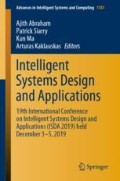Abstract
Parkinson’s disease (PD) is a neurodegenerative disease ranked second after Alzheimer’s disease. It affects the central nervous system and causes a progressive and irreversible loss of neurons in the dopaminergic system, that insidiously leads to cognitive, emotional and language disorders. But until day there is no specific medication for this disease, the drug treatments that exist are purely symptomatic, that’s what encourages researchers to consider non-drug techniques. Among these techniques, speech processing becomes a relevant and innovative field of investigation and the use of machine-learning algorithms that provide promising results in the distinction between PD and healthy people. Otherwise many other factors such as feature extraction, number of feature, type of features and the classifiers used they all influence on the prediction accuracy evaluation. The aim of this study is to show the importance of this last factor, a model is suggested which include feature extraction from 3 types of features (acoustic, prosodic and phonetic) and classification is achieved using several machine learning classifiers and the results show that the proposed model can be highly recommended for classifying PD in healthy individuals with an accuracy of 99.50% obtained by Support Vector Machine (SVM).
Access this chapter
Tax calculation will be finalised at checkout
Purchases are for personal use only
References
Romulo, F., Per, P., Miguel, A.L.N.: Restoration of locomotive function in Parkinson’s disease by spinal cord stimulation: mechanistic approach. Eur. J. Neurosci. 32, 1100–1108 (2010)
Christopher, G.G.: The history of Parkinson’s disease: early clinical descriptions and neurological therapies. Cold Spring Harb. Perspect. Med. 1, a008862 (2011)
Pinto, S., Ghio, A., Teston, B., Viallet, F.: La dysarthrie au cours de la maladie de Parkinson. Histoire naturelle de ses composantes: dysphonie, dysprosodie et dysarthrie. Revue Neurologique 166, 800–810 (2010)
The Michael J. Fox Foundation for Parkinson’s Research. https://www.michaeljfox.org/understanding-parkinsons/living-with-pd/topic.php?speech-swallowing
O’Sullivan, S.B., Schmitz, T.J.: Parkinson disease. In: Physical Rehabilitation, pp. 856–894. F.A. Davis Company (2007)
Achraf, B., Abdelilah, J., Ahmed, H.: Analysis of multiple types of voice recordings in cepstral domain using MFCC for discriminating between patients with Parkinson’s disease and healthy people. Int. J. Speech Technol. 19, 449–456 (2016)
Little, M.A., McSharry, P.E., Hunter, E.J., Spielman, J., Ramig, L.O.: Suitability of dysphonia measurements for telemonitoring of Parkinson’s disease. IEEE Trans. Biomed. Eng. 56, 1015–1022 (2009)
Betul, E.S., Erdem, I.M., Okan, S.C., Ahmet, S., Fikret, G., Sakir, D., Hulya, A., Olcay, K.: Collection and analysis of a Parkinson speech dataset with multiple types of sound recordings. IEEE J. Biomed. Health Inf. 17, 828–834 (2013)
Khan, T., Westin, J., Dougherty, M.: Classification of speech intelligibility in Parkinson’s disease. Biocybern. Biomed. Eng. 34, 35–45 (2014)
Upadhya, S.S., Cheeran, A.: Discriminating Parkinson and healthy people using phonation and cepstral features of speech. Procedia Comput. Sci. 143, 197–202 (2018)
Hinton, G., Deng, L., Yu, D., Dahl, G.E., Mohamed, A.R., Jaitly, N., Senior, A., Vanhoucke, V., Nguyen, P., Sainath, T.N., Kingsbury, B.: Deep neural networks for acoustic modeling in speech recognition: the shared views of four research groups. IEEE Signal Process. Mag. 29, 82–97 (2012)
Anggraeni, D., Sanjaya, W.S.M., Solih, M.Y., Munawwaroh, M.: The implementation of speech recognition using Mel-Frequency Cepstrum Coefficients (MFCC) and Support Vector Machine (SVM) method based on python to control robot arm. IOP Conf. Ser.: Mater. Sci. Eng. 288 (2018)
Mishra, A.N., Chandra, M., Biswas, A., Sharan, S.N.: Robust features for connected hindi digits recognition. Int. J. Signal Process. Image Process. Pattern Recognit. 4, 79–90 (2011)
Young, S., Evermann, G., Hain, T., Kershaw, D., Liu, X., Moore, G., Odell, J., Ollason, D., Povey, D., Valtchev, V., Woodland, P.: The HTK Book, vol. 3. Cambridge University Press, Cambridge (2002)
Kumar, S.C., Mallikarjuna, P.R.: Design of an automatic speaker recognition system using MFCC, vector quantization and LBG algorithm. Int. J. Comput. Sci. Eng. 3, 2942–2954 (2011)
Shete, D.S., Patil, S.B.: Zero crossing rate and energy of the speech signal of Devanagari script. IOSR J. VLSI Signal Process. 4, 01–05 (2014)
Fujimoto, K., Hamada, N., Kasprzak, W.: Estimation and tracking of fundamental, 2nd and 3d harmonic frequencies for spectrogram normalization in speech recognition. Bull. Pol. Acad. Sci.: Tech. Sci. 60, 71–81 (2012)
Boser, B.E., Guyon, I.M., Vapnik, V.N.: A training algorithm for optimal margin classifiers. In: Proceedings of the Fifth Annual Workshop on Computational Learning Theory, pp. 144–152. ACM (1992)
Dellaert, F., Polzin, T., Waibel, A.: Recognizing emotion in speech. In: Proceeding of Fourth International Conference on Spoken Language Processing, ICSLP’96, vol. 3, pp. 1970–1973. IEEE (1996)
Saloni, R.K., Gupta, A.K.: Detection of Parkinson disease using clinical voice data mining. Int. J. Circuits Syst. Signal Process. 9, 320–326 (2015)
Caglar, M.F., Cetisli, B., Toprak, I.B.: Automatic recognition of Parkinson’s disease from sustained phonation tests using ANN and adaptive neuro-fuzzy classifier. J. Eng. Sci. Des. 1, 59–64 (2010)
Breiman, L.: Random forests. Mach. Learn. 45, 5–32 (2001)
Author information
Authors and Affiliations
Corresponding author
Editor information
Editors and Affiliations
Rights and permissions
Copyright information
© 2021 The Editor(s) (if applicable) and The Author(s), under exclusive license to Springer Nature Switzerland AG
About this paper
Cite this paper
Khaskhoussy, R., Ayed, Y.B. (2021). Automatic Detection of Parkinson’s Disease from Speech Using Acoustic, Prosodic and Phonetic Features. In: Abraham, A., Siarry, P., Ma, K., Kaklauskas, A. (eds) Intelligent Systems Design and Applications. ISDA 2019. Advances in Intelligent Systems and Computing, vol 1181. Springer, Cham. https://doi.org/10.1007/978-3-030-49342-4_8
Download citation
DOI: https://doi.org/10.1007/978-3-030-49342-4_8
Published:
Publisher Name: Springer, Cham
Print ISBN: 978-3-030-49341-7
Online ISBN: 978-3-030-49342-4
eBook Packages: Intelligent Technologies and RoboticsIntelligent Technologies and Robotics (R0)

